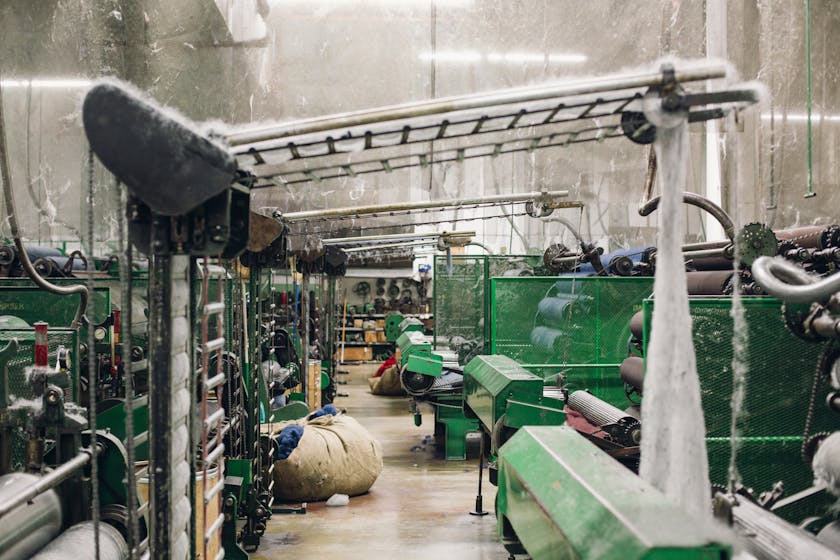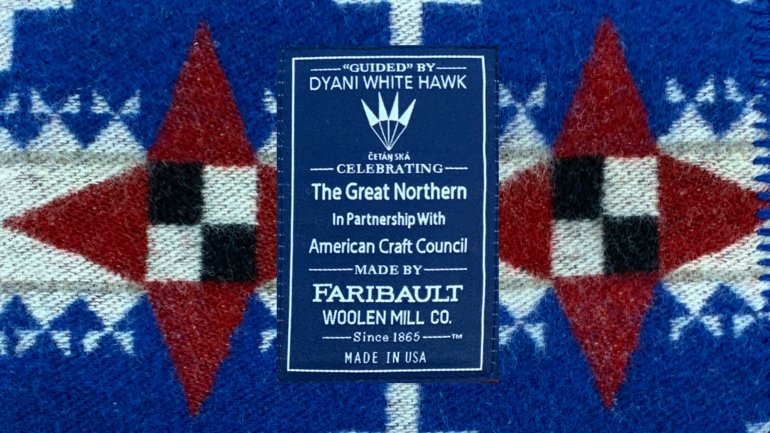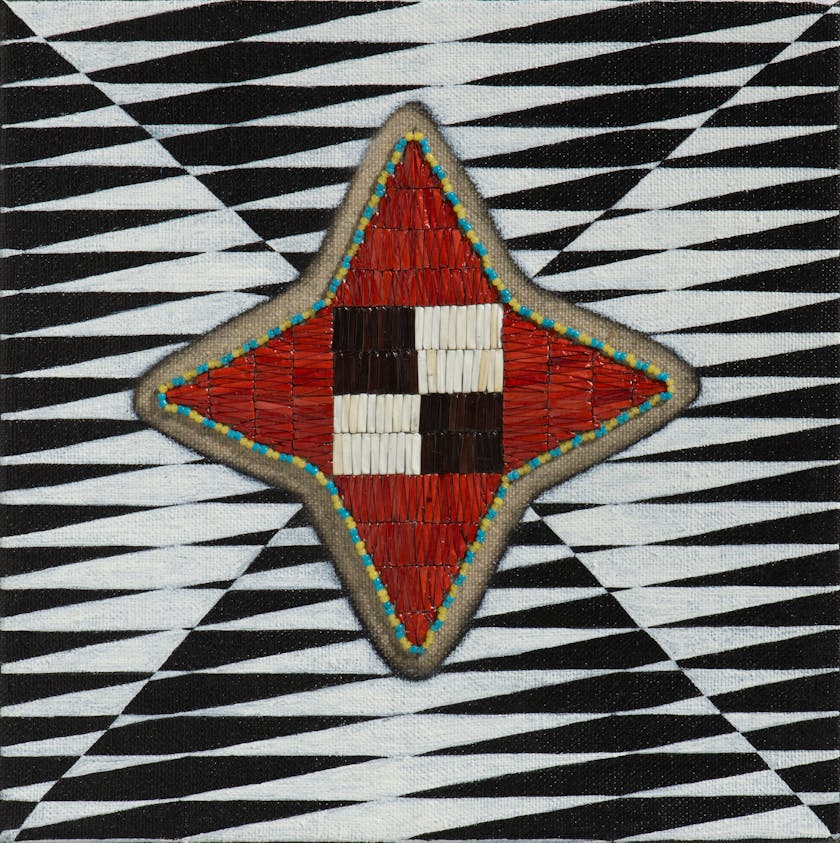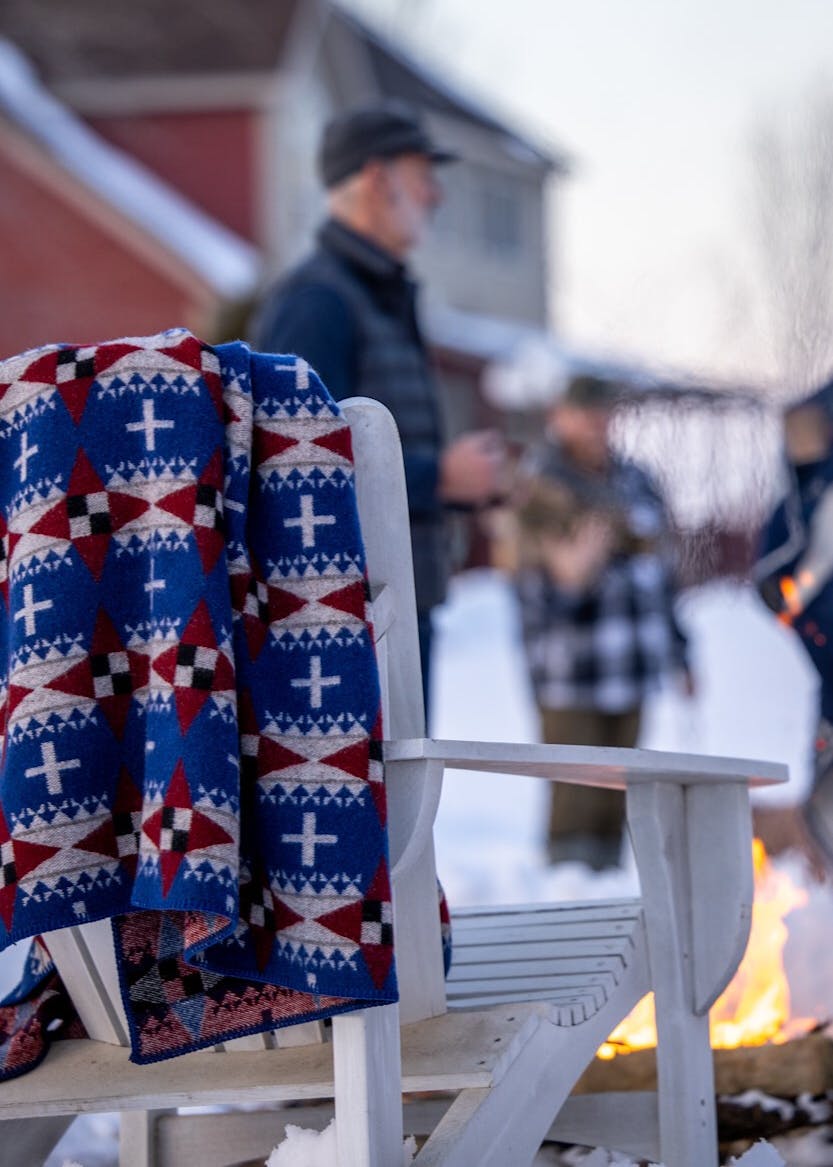Guided: An Interview With Dyani White Hawk
The Minneapolis-based visual artist shares about the limited-edition blanket she designed in collaboration with ACC, The Great Northern, and Faribault Woolen Mill.

Dyani White Hawk. Portrait: David Ellis.
Dyani White Hawk (Sičáŋǧu Lakota) is a visual artist who designed a limited-edition blanket entitled Guided as part of The Great Northern, in partnership with the American Craft Council. Dyani was inspired by her quilled painting Black and White IV, which contains a red star inspired by Oceti Sakowin (Lakota, Dakota, and Nakota) quillwork. Collaborating with Faribault Woolen Mill to translate her design into weaving, Dyani incorporated elements of her culture and a subdued winter theme to create Guided.
Interview by Jaida Grey Eagle.
You got to tour the Faribault Mill. How was that experience?
Me and my brother in law Noah, who is now working as my studio assistant, went together. They gave us a complete tour; it was amazing. We walked through the entire building, learning about the various processes of wool blanket production. Faribault Woolen Mill and Pendleton are the only vertical mills in the US, which means their work starts with raw wool and ends with the final woven product. They clean, spin, and dye the yarn before weaving the blankets. Other companies that weave wool blankets receive the yarn ready to weave. My understanding is that Faribault and Pendleton are the only two mills that still do this work from beginning to end.
It's an extensive process, and there are giant, old industrial machines you can tell were built and/or designed in the era when this process was first industrialized. One of my first questions walking through the production floor was, "Are there even parts to fix these?" and "Do people know how to service them?" I recognized that the specialization in this type of equipment may lie within our grandparents' generation.
Much of the equipment is tremendously large. I can’t even imagine how much it must weigh. Our tour guide shared a story about cutting a hole in the floor to move equipment. She also shared that the people who know the equipment well are older, retiring, and/or passing away. Getting people in and trained on how to care for and service the equipment is an ongoing task for Faribault. I found that fascinating. It's a truly beautiful building and mill. As we walked, we saw evidence of each step, how debris is separated from the wool, how it is washed, dyed, dried, and how the wool is spun into yarn. We saw stacked towers of bundles of raw wool waiting to be processed. I looked at that thinking, "WOW, that's a lot of sheep!” I felt a moment of sincere gratitude for the gifts of warmth we receive from them. Once the wool is spun into yarn, it is spun onto large spools. Then there is an intricate and expansive process to set up the warp threads on the loom. Watching the machines doing the actual weaving is fascinating! To really be able to see and understand what was happening, we took slow motion video footage on our phones. Otherwise, the machines move too fast to be able to see each step. It was an educational experience. The Faribault staff were kind, welcoming, and generous in sharing the unique and intense work that it takes to provide us with a beautifully woven blanket.

One of the oldest pieces of machinery at Faribault Woolen Mill is this carding machine from 1905, which is still in use. Photo: Courtesy of Faribault Woolen Mill.
At first, I was hesitant to take on the project because I already had so much on my plate. But by the time I left, I was so impressed and inspired, I just couldn’t pass it up!
I've wanted to work with Faribault for years—I was gifted a Faribault blanket in 2013 when I received a McKnight fellowship. The McKnight Foundation gave all the fellows that year beautiful monochromatic grey blankets that said "artist" in the McKnight branded font across the blanket. I cherish my blanket. It's such a simple, bold, and balanced design. And it’s the best blanket for studio napping! Ever since, I've thought about how wonderful it would be to have an opportunity to design blankets with them. So, even with a long to-do list, after the walkthrough, I was quickly convinced I wanted to work with the mill. The nice thing about Faribault being a smaller business is that these guys can really knock it out. It doesn’t take quite as long to redirect the ship. I gave them the file today and the first batch will be woven by mid-January.
Did seeing the mill help shape your design?
Not necessarily, but it did get my creative wheels turning. They provided me with samples of the yarn colors they had available, which helped shape things for sure.
What was your inspiration for the blanket?
I sat down with the folks who work there (Faribault Mill employees), and together we looked at my website and potential pieces that could be translated into a blanket. We were all excited about a few promising directions.
The red star that is now the prominent design in the Guided blanket is from a quilled painting I had done in the past. We experimented with translating the entire painting, but the background of the original work is really complex, and while it works for the painting, it felt too aggressive for a blanket design. I liked the idea of working with that particular star motif, which is influenced by older Oceti Sakowin quillwork. It's not something I've seen woven into a blanket, so I decided I wanted to build the design around that element.
The other inspiring force was a request from the folks at The Great Northern to create something with a winter theme. I considered it for a while and eventually wrote them asking if the blanket itself could be the winter theme so that I could be free to create without restriction. They laughed and said, “Yes, of course—you can just make what you want to make.” I was relieved, yet I still kept the request in mind. The color palette ultimately was guided by the feeling of winter. The slightly older-looking blue, deeper, more muted red, and the tipis and the bands in between in white, all keep in theme with a cooler, more subdued feeling. It feels like a quiet evening winter sky against a snowy landscape.
How about the tipis? Were those inspired by a painting?
No, they came about through the design process. The stars were placed first. Then I began experimenting with various striped backgrounds. The four direction crosses came in next. I tried several variations in the striping, placed different elements in between the stripes looking for a blanched design, tried different color combinations, experimented with some zigzags, and nothing was working. Then I thought, "Oh, tipis!" and as I put them in, it spoke to the feeling of winter for me. I envisioned all these quiet lodges, a camp in the snow against a quiet deep blue sky. It just felt right.
How do you see your relationship with winter as a contemporary Lakota woman?
I’ve thought about that a lot over the years, and while designing this blanket. I try to envision the way our relatives moved through winter. I realize the drastic differences of our lives today versus our ancestors' lives, especially in winter. I think about the whole tiospaye (extended family) setup, community, setting up tipis in snow; what it would take to have enough firewood to stay warm, cook, hunt and all that it took to sustain life through hard winters. I admire the level of knowledge and skills our relatives possessed to live through northern winters in ways that were in sync with the land and all of life.
I think about how different our lives are now compared to then. I'm sure there are blessings we miss out on now from a life lived in that manner, and blessings we have now that our ancestors would have loved to experience.
When you asked this question, my mind immediately went to harvesting cansasa (red willow bark), I thought, “That's what we do in winter.” Harvesting cansasa is something that marks this time of year. It grounds me as a Lakota woman, and provides teachings on the importance of planning and preparing for the year ahead.
Last, but not least, I love snowboarding! It was one of my earliest passions. I don't get to do it nearly as much as I’d like, but I love it dearly. I love being out in the snow. I love the freedom of riding and the exercise in the cleansing cool air. The pace of winter feels different from the energy of summer. There's a nurturing in it that's unique, how the air feels in winter—the mood is different. I have appreciated this time of year ever since I was young.
What was the inspiration behind the title Guided?
I went for a run, which is a time I rely on for uninterrupted thought and prayer. It was on the 30th, the evening of the full moon. I headed out at the end of the day and was surprised how quickly the sun set, and evening arrived. I thought I would be back before dark, but I miscalculated. I ended up being so grateful though because on my route home, I was running toward the full moon. It was really bright and low in the sky—a big, beautiful, golden full moon. I was thinking about the blanket and what it meant to me as I was trying to decide on the title. I thought about winter, the North Star, stars in the winter sky, that celestial presence and the guidance embedded in our symbolism. I also thought about how life and the necessity of guidance can be different in winter. I thought about what that all means to me, but also about the importance of finding a title that provides an open invitation for others to find meaning that is applicable to their lives, that purposefully leaves room for personal interpretation, allowing folks to apply meaning that speaks to what guides them.
The worldviews that are embedded within the symbolism in the design are culturally specific. Yet, the symbolism is not exclusive to Lakota people. As I thought about what those symbols speak to, I thought of the word “Guided.” Other Oceti Sakowin people may think similarly when they view the design because of common cultural teachings. Native people from other tribes will have their own cultural references. Non-Native people may see it and perhaps they’ll think about the North Star, the history of this land base, or perhaps they’ll see family and community. Or, they might think about the ways their lives are guided by faith, or values.
Was there anything that you wanted to mention about this collaboration that I didn't ask?
I'm just grateful to have had the opportunity to get to know the people and organizations involved in this project. I think it's beautiful that Minnesotans and people living in this region dig winter enough to have a whole festival focused on the season. There are so many people who cringe at the thought of winter. But here, we learn how to play in and enjoy it. We gather together around the celebration of this season, which is the guiding force of The Great Northern, and I’m happy to be a part of that.
American Craft Council featured my work in the December/January issue of their magazine, American Craft. They approached me for the article first. Afterwards, they proposed the blanket collaboration between ACC, The Great Northern, Faribault, and myself. This was then followed by a feature on their blog titled The Queue. I've admired how we're just getting to know each other and already, it's this multi-tiered collaboration.
Everybody at Faribault has been amazing to work with. They are a really kind crew of people. I also think it is important to mention my appreciation of the intentionality in Faribault’s pricing. At $195, they are carefully considering accessibility. This price point is a lot easier for many families and individuals to achieve than other wool blankets on the market. The fact that there are only two vertical mills in the country, and one is in Minnesota—that’s special, and something I want to see continue to thrive.
The proceeds of this blanket benefit multiple organizations and entities. Our collaboration allowed Faribault to branch out and diversify what is offered through their mill and offer financial support to a working artist, the American Craft Council, and The Great Northern. American Craft Council and The Great Northern have a wide reach and benefit a great deal of people, both artists and the greater public. I really appreciate the wide communal reach of this collaboration and am grateful to have been invited to be a part of it.
Order your Guided blanket today
For every blanket sold, Faribault Woolen Mill will donate $100 to support ACC and The Great Northern.






